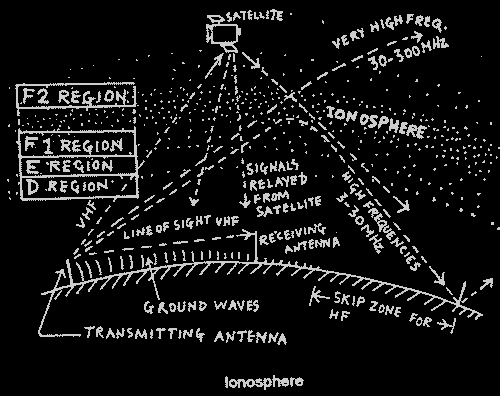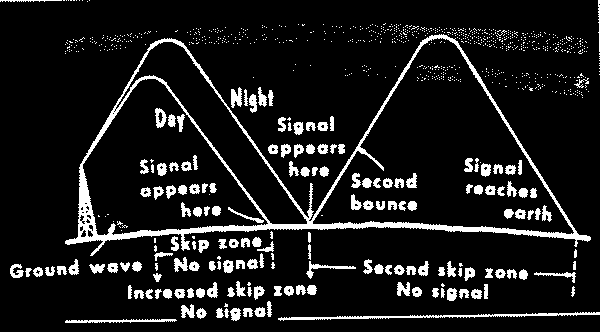
|

|
Short wave or High Frequencies (HF) in the range of 3-30 MHz propagates through an invisible layer which consists of charged particles located at altitudes of between 250 and 400 km in the atmosphere surrounding the Earth. This layer of charged air particles called F2 layer of the ionosphere plays a vital role in HF propagation by reflecting or refracting the HF signals back to Earth.
The ionosphere has got different sub-layers. The lowest is D-layer at altitudes ranging from 50 to 90 km. High frequencies (3-30 MHz) penetrate this layer, while low frequency (LF: 30-300 kHz) or medium waves are absorbed by this layer. To some extent LF and Very Low Frequency (VLF: 3 to 30 kHz) are reflected during daytime. It slightly scatter and absorbs HF. This layer subsists only during daytime.
The E-layer extends from an altitude of 100 km. Though sunlight is an important factor for its existence, after sunset also it exists for some time. This layer is responsible for evening and early night time propagation of medium waves (low frequency) upto a distance of about 250 km. Propagation of lower short wave frequencies, e.g. 2 MHz , up to distance of 2000 km at daylight time is due to this layer. It has little effect at night.
F1 layer exists at an altitude of 200 km during daytime and its characteristics are very similar to E-layer which emerges into F2 layer at night. F2 layer is the most important layer which exists at altitudes ranging from 250 to 400 km and HF long distance propagation round the clock is due to this layer. The behaviour of this layer is influenced by the time of the day, by season and by sunspot activity. F2 layer was formerly known as Appleton layer. This layer has a high ionization gradient. This layer exists both in the daytime and nighttime. Since at such an altitude air density is extremely low, the free ions and electrons (due to the action of ultraviolet radiation from the Sun) can not recombine readily and so can store energy received from the Sun for many hours; that is the reason the refractive property of this layer changes only to a negligible extent during day and night. The path which the short wave signal follows through the F2 layer is in reality a curved one. Degree of the curve depends on the angle of incidence of the wave, ionization gradient of the layer and frequency of the signal.
 Image Source: Basic Radio (Vol-6 P:6-129/ 1969 edition) by Marvin Tepper
|
Under the action of solar radiation and the hail of meteorites, an ionized layer is formed in the upper part of the Earth's atmosphere. In this layer, the neutral air molecules are decomposed into ions and electrons and the whole layer presents a chaos of charged particles.Short wave radio signals are reflected from this layer just as light rays are reflected from the surface of a mirror, or sound from a barrier.Likewise, this layer can be compared with the edge of billiard table: if the ball does not go straight into the pocket, it can be sent on rebound. In a situation, a radio receiver set located at a distance of 200 kilometres (say) away from the wireless transmitting station can not receive signals from the transmitting station. This is because the ground waves are stopped by the Earth's curvature and the sky wave will not reach the receiver, because it bounces again more than 200 kilometres way. So some 'blind zones' are formed and if the receiver is located in that blind zone it will receive no signal or very weak signal. In such a situation, another station can relay the message to the target station. The distance of the intended receiver from the transmitter is then termed as 'skip distance'. So it is not always necessary that a receiving station located nearer (than a station located further away from the transmitting station) to the transmitting station will be able to receive its signal.
|
The problem of variable propagation conditions can be partially overcome by using frequency diversity, in which an allotted communication network is provided with several frequency assignments spanning the High Frequency (HF) band of frequencies. The ham can choose the frequency that gives the best results at any given time. Similarly if a station is in skip at a particular frequency, another frequency can be found out.
The radio frequencies above 30 MHz has the tendency to penetrate the ionosphere making them unsuitable for long distance propagation. So, the range of frequencies from 30 to 300 MHz (also 300 MHz and above), which are placed under the Very High Frequency (VHF) category are mainly used for line-of-sight communication. The most common example of line-of-sight communication is the TV Telecast. A TV transmission tower is made as tall as possible so that its signals can have a wide area of coverage. To receive a TV telecast, we have to turn our TV antenna (known as a Yagi antenna) towards the TV transmission tower. In areas where the TV transmission tower is located at a far away place from a viewer, the viewer has to increase the height of his TV receiving antenna. This means that both the transmitting and receiving antenna should literally see each other to make the communication effective. Otherwise there should be some means to redirect the signal back to the receiver. Artificial Satellites in space (which houses active electronic relaying device), terrestrial relay station and passive reflectors (the metallic plates we see above the hills) are employed to extend the VHF coverage. Line-of-sight communication is considered reliable within a short distance.
|
Image source: Practical Wireless Magazine (Issue unknown)
In case of line of sight reception, there are two components of the signal. One is the direct signal and other is the signal reflected from the ionosphere. Both the signals leave the antenna with the same signal phase, but travel different paths to the receiving antenna. These paths may be of different length. Because the reflected signal suffers 180 degree phase reversal at the point of reflection, the two signals may aid or oppose each other in the receiving antenna. The resultant signal may be stronger or weaker than the direct path signal alone which is not desirable.
|
Image Source:
Basic Radio (Vol-6 P:6-127 1969 edition) by Marvin Tepper
The line-of-sight propagation is limited to the optical horizon and it is only about 75 miles for frequencies above 30 MHz; but it is found that in the spring or fall, or sometimes in summer, this line-of-sight propagation extends to about 500 miles. This is due to the presence of layer of hot, dry air above a layer of cool, moist air. The direct waves are bent back which otherwise pass over the receiving antenna.
|
Fade-out
It is the gradual phenomenon, that take place with the change of time of the day. Fadeout of radio signal is related to the ionization gradient of the ionosphere, which decreases in absence of sunlight. Since ionization is intense during day light hours, higher frequency (like 14 MHz and 21 MHz) of the short wave spectrum can be used during daylight hours. As the night approaches, signal strength at that higher frequency decreases. Using a frequency at the lower edge of the HF spectrum (e.g. 7 MHz) will yield satisfactory result against this fadeout.
Fading
As distinct from fade-out, fading is the constant variation of the received strength of radio wave. To the listener it appears as gradual rising and falling of the volume. The signal waxes and wanes and at times even drops below usable values. This phenomenon is manifested chiefly in long-distance transmission. It is caused by multiple reflections from the ionsphere which cause two or more waves from the same transmitter travel over different paths of different lengths and hence differ in phase and amplitude when they arrive at the receiving aerial.
Page
maintained by Sandeep Baruah, VU2MUE (Ex-VU2MSY)
Last update on 19.12.1999